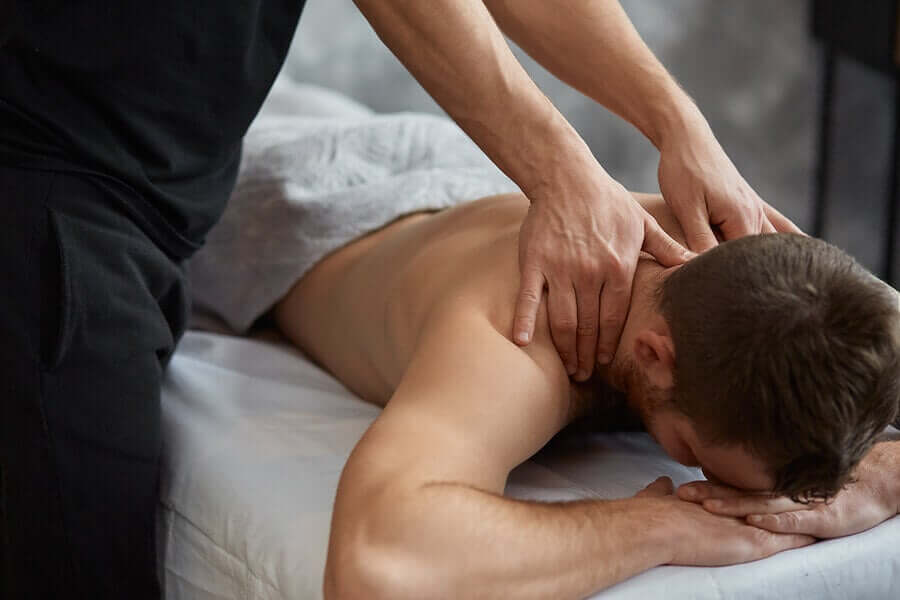Learn How to Treat Neck Spasms


Written and verified by the doctor Nelton Abdon Ramos Rojas
When a cervical contracture occurs, the blood vessels that supply them with blood are compressed; consequently, the sprain or contracture worsens. Often, the most affected muscles are the trapezius and levator scapulae.
Fortunately, it’s rarely caused by a serious health problem and can be improved by exercise, massage, and other non-invasive treatments. What are the best options? When to consult a doctor? In the following space we’ll explain everything you need to know about neck spasms.
Neck spasm symptoms
Identifying a neck spasm isn’t that difficult because the main symptom is intense neck pain. In some cases, there’s prolonged pain, and in others, it happens sporadically. Here are the main symptoms:
- Inflammation.
- Sharp, throbbing pain.
- Tingling sensation.
- The area is warm to the touch.
- Muscle pain.
- Your neck is so stiff you have to turn your whole body to turn your head.

Most of the time, neck spasms don’t lead to serious problems. However, you should treat the strain in time in order to prevent even more painful side effects. If your doctor suspects that you have a more serious injury, they might suggest one of the following tests:
- X-ray
- Blood tests
- Electromyography (EMG)
- MRI
- CT scan
Also read: 8 Tips for Better Posture
Causes
There are many possible causes of neck spasms, and they can affect anyone. They are a common muscular injury, and some factors increase your risk of getting neck spasms. Some include:
- Overworking.
- Muscle weakness.
- Repetitive use of muscles.
- Exposure to stressful situations.
- Uncomfortable positions that put a strain on the neck for long periods of time.
How can you treat neck spasms?
As long as the cervical contracture doesn’t originate from a serious injury or illness, it’s possible to relieve the symptoms with some self-care measures. If the pain’s severe and doesn’t improve soon, it’s best to seek medical attention. Here’s what can help relieve it:
Over-the-counter pain medication
One of the first recommendations to relieve pain caused by cervical contracture is to take an over-the-counter pain reliever such as aspirin, ibuprofen, naproxen sodium, or acetaminophen.
However, as detailed in an article published in the National Center for Biotechnology Information, the intake of these medications should be moderate, for a few days. In case of having any previous disease, or being under medical treatment, it’s best to consult a physician before taking them.

Cold compresses
The application of cold compresses contributes to the treatment of neck pain for several reasons. First, they help numb the affected area, providing a feeling of temporary relief. On the other hand, as detailed in an article published in the University of Rochester Medical Center Rochester, NY, they decrease inflammation.
It’s important to apply the cold as a compress, since ice alone can be aggressive to the skin. In case of cervical contracture, it’s applied to the affected area for 10 minutes. If the pain persists, repeat the remedy 2 or 3 more times.
Heat therapy
According to the article mentioned in the previous section, heat can also be useful in case of pain. Its application in compresses stimulates circulation, decreases stiffness, and soothes pain. However, this option shouldn’t be used within the first 48 hours after an injury.
Massage
A massage applied by a physical therapist or professional masseuse can contribute to the relief of this ailment. A study published in the Journal of Manipulative and Physiological Therapeutics found that even short massage treatments are helpful in relieving neck pain.

Moderate exercise
For problems such as cervical contracture, your doctor may suggest sessions with a physical therapist to help restore range of motion. While some rest is soothing, too much can be harmful. Therefore, total inactivity isn’t recommended.
Gentle stretching, moderate exercise, and activities that don’t involve too much exertion are ideal for maintaining movement while relieving this ailment.
Visit this article: 5 Natural Remedies for Neck Pain
When to see a doctor
Never ignore the fact that neck spasms may require medical attention. If symptoms worsen or persist for several days, it’s best to see a professional. It’s also advisable to consult if:
- The pain is the result of a fall or injury.
- There’s loss of bladder or bowel control.
- In addition to pain, there’s numbness of the back, limbs, or other parts of the body.
- There’s difficulty moving the limbs.
- There’s a high fever.
In all of these cases, treatment may vary according to the underlying cause. It’s likely that complementary tests will be required, as well as medications or other therapeutic options to those already mentioned.
All cited sources were thoroughly reviewed by our team to ensure their quality, reliability, currency, and validity. The bibliography of this article was considered reliable and of academic or scientific accuracy.
- Haik, J., Prat, D., Kornhaber, R., & Tessone, A. (2016). Treatment of cervical contractures utilising a closed platysmotomy like approach: Case report and review of the literature. Burns. https://doi.org/10.1016/j.burns.2016.03.026
-
InformedHealth.org [Internet]. Cologne, Germany: Institute for Quality and Efficiency in Health Care (IQWiG); 2006-. Using medication: The safe use of over-the-counter painkillers. 2016 Apr 6 [Updated 2017 Aug 10]. Available from: https://www.ncbi.nlm.nih.gov/books/NBK361006/
- Binder AI. Neck pain. BMJ Clin Evid. 2008;2008:1103. Published 2008 Aug 4.
- Cohen, S. P. (2015). Epidemiology, diagnosis, and treatment of neck pain. Mayo Clinic Proceedings. https://doi.org/10.1016/j.mayocp.2014.09.008
-
Bakar Y, Sertel M, Oztürk A, Yümin ET, Tatarli N, Ankarali H. Short term effects of classic massage compared to connective tissue massage on pressure pain threshold and muscle relaxation response in women with chronic neck pain: a preliminary study. J Manipulative Physiol Ther. 2014;37(6):415‐421. doi:10.1016/j.jmpt.2014.05.004
-
InformedHealth.org [Internet]. Cologne, Germany: Institute for Quality and Efficiency in Health Care (IQWiG); 2006-. Neck pain: Overview. 2010 Aug 24 [Updated 2019 Feb 14]. Available from: https://www.ncbi.nlm.nih.gov/books/NBK338120/
This text is provided for informational purposes only and does not replace consultation with a professional. If in doubt, consult your specialist.








